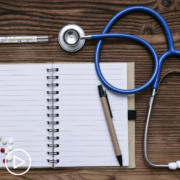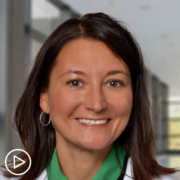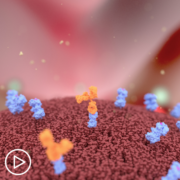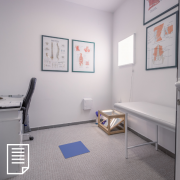What Are the Goals of DLBCL Treatment?
What Are the Goals of DLBCL Treatment? from Patient Empowerment Network on Vimeo.
A diffuse large B-cell lymphoma (DLBCL) treatment plan may have different goals depending on the patient. Expert Dr. Loretta Nastoupil provides an overview of factors that play into treatment decisions and shares information about current and emerging DLBCL treatments.
Dr. Loretta Nastoupil is Director of the Lymphoma Outcomes Database in the Department of Lymphoma/Myeloma at The University of Texas MD Anderson Cancer Center. Learn more about Dr. Nastoupil, here.
See More From The Pro-Active DLBCL Patient Toolkit
Related Programs:

|
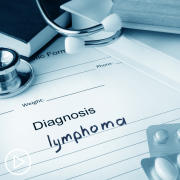
|
Transcript:
Katherine:
Many factors come in to play when making a treatment decision, including a patient’s age and overall health. So, let’s walk through some of these considerations. Let’s start with treatment goals. What does this mean exactly? And what are the goals of treatment for DLBCL?
Dr. Nastoupil:
Great questions. For diffuse large B-cell lymphoma, my goal was that I want to eradicate this disease with one course of therapy. Now one course of therapy, again, may mean six cycles of treatment, or it may mean three to four plus/minus radiation. And that kind of gets back to the discussion we just had with stage. But the goal is to make it go away and never come back. Now, oncologists are eternal optimists.
And I saw this because we would not be oncologists if we weren’t always focused and hoping for the best outcomes for our patients.
Katherine:
Sure.
Dr. Nastoupil:
So, we, generally, when we’re counseling patients tend to keep the focus on what is the chance that I can cure this, and we use words like cure oftentimes. But there’s always those caveats. And those caveats are – we can’t really look into our crystal ball and predict the future for every given patient. So, we use tools to help us risk stratify patients, meaning if we took 100 people like a given person, we could predict the outcome for the majority of those patients.
So, with diffuse large B-cell lymphoma with no high-risk features – so, that gets back to the molecular subtype. Do they have double hit features – yes or no? The stage and something we call IPI, International Prognostic Index, that takes into account some clinical features. As you mentioned, patient specific factors, their age, their stage, some lab values, whether or not they have more than one extranodal variable. Then we can generally predict.
Again, if I have 100 patients with good risk IPI, 80 percent of them are likely to be cured and alive and well five to 10 years later. If I have someone with poor risk features that may not change exactly what I do for that patient, but that may help them and me in terms of should I be pursuing a trial to potentially have access to something that’s better than this standard option? Or how does this impact their planning?
Some people are close to retirement. Some people have specific life goals, such as a wedding or an anniversary that sometimes we use those sorts of calculators to best predict the future to inform some of that treatment. So, those are what we call sort of the characteristics coming into treatment.
There are comorbidities or sort of concomitant medical problems, such as heart disease, sometimes diabetes. But, generally, more often than not, it’s how healthy your heart is because my objective with treatment is to cure this.
Cure generally results from chemotherapy. And we can spend some time talking about why have we not moved away from chemotherapy in this disease? But, generally, that does involve chemo because that’s generally how I can eradicate this tumor.
But there are certain situations where that chemo may not be beneficial to a given a patient. It usually has to do with how healthy their heart function is at baseline. So, again, we look at all of these factors. What is their risk with the disease? What is their risk from the toxicity of treatment? And am I able to achieve that goal, which is to eradicate the disease?
Katherine:
Well, let’s talk about chemotherapy. Why is that still part of the regimen in a treatment plan?
Dr. Nastoupil:
Yes, I’m going to borrow an analogy that one of my colleagues Jason Westin uses all the time. The CHOP chemotherapy that is the backbone of our treatment for diffuse large B-cell lymphoma was developed in 1976.
There is no other technology that we would commonly use in our day to day. You wouldn’t still be driving your car you had in 1976. Clearly, our methods of communication in regards to phones have changed dramatically. So, why are we still using chemotherapy that was developed in 1976?
Katherine:
True.
Dr. Nastoupil:
Well, it’s not for lack of trying. Over the last four or five decades, we have been trying to improve upon this. And it works. It works for at least 60 percent of patients. When we tack on targeted therapy, such as immune
therapy where we use an antibody that will stick to the surface of a marker on that lymphoma cell and then use the immune system to do some of the heavy lifting, we can probably improve those cure rates from 60 percent to potentially as high as 80 percent. That’s really been the only substantial improvement we’ve made.
Now, there is one caveat. So, just recently, we heard a press release of the POLARIX study, which is the first trial in the last four decades that could potentially replace R-CHOP as the standard of care.
We don’t have the full results yet. It’s essentially utilizing a drug called polatuzumab, which is an antibody drug conjugate. It’s essentially chemo on a stick. But we’re delivering chemo specifically to (CD)79b, which is a target on B cell lymphomas and modifying the CHOPs. We’re not getting rid of chemo altogether. We’re dropping one of the chemotherapy agents and replacing it with this targeted agent. So, it’s essentially CHOP plus rituximab and polatuzumab might be the new standard.
But, again, that’s based off many, many efforts to try and replace CHOP. And we’re making slow incremental improvements, but we’re still keeping the therapies that tend to work.



